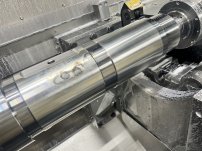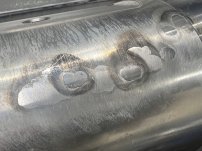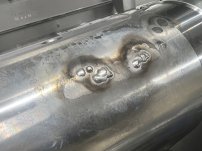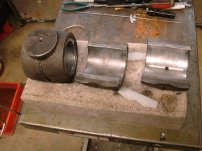I work for a company that makes parts for the aerospace industry. We have a run of shafts we are currently doing that have two separate Babbitt bearing journals on each part.
We noticed when these shafts arrived there was a significant amount of “porosity” or small pinhead sized holes in the Babbitt sleeve.
The Babbitt sleeve is approximately .015” thickness over the top of the journal per side.
Typically we do what we refer to as “puddle filling” these small holes using astm grade 2 Babbitt coil. Using an oxy acetylene torch with a size 00 torch tip. I slowly heat up the area containing the holes and get them to melting point, at which time I dab in a small drop of astm grade 2 babbitt coil.
We then machine off the extra Babbitt and typically after one or two tries we get the holes filled. However in this last batch we are having significant issues getting the holes filled. We will puddle fill the holes, then make a cutting pass and more holes will appear. Can’t figure out a solution. We clean the area throughly, make sure it’s completely dry before doing our puddle fills. We even tried using a flux that was recommended from the company we purchase the Babbitt from. Still not getting better results. Anyone have experience with this issue?


We noticed when these shafts arrived there was a significant amount of “porosity” or small pinhead sized holes in the Babbitt sleeve.
The Babbitt sleeve is approximately .015” thickness over the top of the journal per side.
Typically we do what we refer to as “puddle filling” these small holes using astm grade 2 Babbitt coil. Using an oxy acetylene torch with a size 00 torch tip. I slowly heat up the area containing the holes and get them to melting point, at which time I dab in a small drop of astm grade 2 babbitt coil.
We then machine off the extra Babbitt and typically after one or two tries we get the holes filled. However in this last batch we are having significant issues getting the holes filled. We will puddle fill the holes, then make a cutting pass and more holes will appear. Can’t figure out a solution. We clean the area throughly, make sure it’s completely dry before doing our puddle fills. We even tried using a flux that was recommended from the company we purchase the Babbitt from. Still not getting better results. Anyone have experience with this issue?






